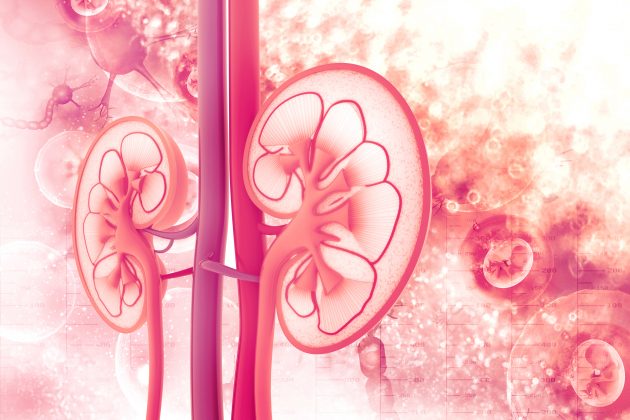Patients with kidney failure on maintenance dialysis are particularly vulnerable to COVID-19. The average age of patients on maintenance dialysis is 65 years. Further, patients in that population commonly have multiple comorbidities such as diabetes, obesity, and uremia-induced impaired immunity, putting them at increased risk for poor outcomes in COVID-19.
Patients with kidney failure are commonly more socioeconomically disadvantaged that the general population and live in more densely populated urban areas, putting them at increased risk for acquiring SARS-CoV-2. The need for in-center hemodialysis and associated transportation may require patients to forego effective physical distancing. The combination of these factors is also present in individuals who reside in long-term care facilities.
As of June 2021, the Centers for Medicare & Medicaid Services reported a COVID-19 prevalence of 3.8% in the dialysis population. To provide further characterization of COVID-19 among US patients on dialysis, Caroline M. Hsu, MD, and colleagues conducted a retrospective cohort study to examine risk factors for COVID-19 among dialysis patients treated by Dialysis Clinic Inc. (DCI), a medium-sized national not-for-profit dialysis provider treating more than 15,000 maintenance dialysis patients at 260 outpatient dialysis clinics in 29 states. The researchers also sought to assess the risk of and risk factors for mortality in patients on maintenance dialysis. Results of the study were reported in the American Journal of Kidney Diseases [2021;77(5):748-756].
The primary outcomes of interest were diagnosis of COVID-19 by nasopharyngeal or oropharyngeal swabs sent locally for reverse transcriptase-polymerase chain reaction testing, and all-cause death within 90 days of COVID-19 diagnosis among those diagnosed with COVID-19, compared with those at the same clinic without a COVID-19 diagnosis. In patients without COVID-19, all-cause death was defined by death within 90 days of the first COVID-19 diagnosis at the source clinic. Patients were followed until death or 90 days, whichever came sooner, through September 1, 2020.
Eligible study participants were maintenance dialysis patients at DCI clinics with at least one patient who tested positive for SARS-CoV-2 from February to June 2020. Clinical characteristics associated with COVID-19 and risk factors associated with mortality among patients following COVID-19 were identified using logistic regression analyses.
During the 15-week study period, 438 maintenance dialysis patients had a diagnosis of COVID-19, representing ~3% of 15,200 patients treated in DCI clinics. Not all states and clinics were exposed to COVID-19 in the early pandemic surge; the 438 patients with a positive COVID-19 diagnosis represented 5.5% of 7948 patients in impacted clinics.
Compared with patients without COVID-19 in the impacted clinics, those with COVID-19 were older, and more likely to be Black, to be treated with in-center hemodialysis, to be treated at an urban clinic, to use respiratory inhalers, and to reside in a congregate setting such as a nursing home. COVID-19 patients also had higher comorbidity burden, and higher prevalence of cardiovascular disease, diabetes, and the need for assistance with activities of daily living and/or use a wheelchair.
In multivariable models, risk factors for COVID-19 infection in patients on maintenance dialysis were male sex, Black race, being treated at an urban clinic, residing in a congregate setting, the presence of comorbid conditions, and having a diagnosis of atherosclerotic heart disease and diabetes. Patients undergoing home dialysis were less likely to have COVID-19 infection.
The 438 patients with a COVID-19 diagnosis were followed until death or censored at 90 days. Of the 438, 109 (24.9%) died, compared with 275 of 7510 (3.7%) of the dialysis patients without COVID-19. A total of 296 of the patients with COVID-19 (67.6%) received care at the emergency department or as a hospital inpatient either at the time of diagnosis or within 30 days of diagnosis. Of those 296 patients, 95 (32.1%) died. Of those deaths, 86 occurred during hospitalization and nine occurred following initial hospital discharge. The remaining 201 patients were considered recovered by the end of follow-up.
Of the 142 patients (32.4%) who were not initially hospitalized, 14 died within 30 days of diagnosis (eight of those in nursing homes, two in hospice, two had unknown site of death, and two died at home), and another nine patients were hospitalized ≥30 days after diagnosis. Three of the nine were admitted due to COVID-19 and the other six received inpatient care for various other medical conditions. As of the end of follow-up, all 128 surviving outpatients were considered recovered from COVID-19.
Mortality was higher in older patients, particularly those >80 years of age. Patients who died had higher prevalence of comorbidity related to chronic heart failure, hypertension, and other cardiovascular disease as well as peripheral vascular disease, low albumin level, and use of a wheelchair. In multivariable models, older age became strongly associated with death, with increased risk of death in each decade after the age of 50; peripheral vascular disease, chronic heart failure, hypertension, and wheelchair use also remained significantly associated with risk of death.
Citing limitations to the study findings, the researchers included the observational design of the study, focusing on data from the dialysis provider with limited details surrounding in-hospital events; extremely limited testing data early in the pandemic that may have resulted in underestimation of COVID-19 cases and misclassification of deaths; the difficulty in determining the cause of death in this population given the extensive comorbid condition burden; excluding dialysis clinics with no COVID-19 cases that may have resulted in the introduction of other biases; the inability to distinguish asymptomatic carriers of COVID-19 from those with symptomatic disease; and the small number of home dialysis patients with COVID-19 identified during the study period.
In conclusion, the researchers said, “Dialysis patients are at high risk of COVID-19, with 5.5% of patients with a diagnosis of COVID-19 in facilities with at least one COVID-19 case during the first 3 months of the pandemic in the United States. In-center dialysis, residence in a long-term care facility, and Black race are all major risk factors associated with COVID-19, suggesting that the ability to maintain physical distance is critical to controlling COVID-19. Mortality among dialysis patients with COVID-19 exceeds 20%. To address COVID-19 while awaiting availability of safe and effective vaccines and therapeutics, dialysis facilities should recognize risk factors, maximize utility of telemedicine, promote home dialysis, encourage transplantation where appropriate, and optimize socio-culturally adapted education regarding physical distancing and universal precautions including masking, not limited to the dialysis clinic but relevant to all other at-risk settings.”
Takeaway Points
- Researchers reported results of a retrospective cohort study characterizing the risk factors and outcomes following COVID-19 in patients receiving maintenance dialysis.
- A total of 438 of 7948 (5.5%) maintenance dialysis patients were diagnosed with COVID-19; male sex, Black race, in-center dialysis (vs home dialysis), treatment at an urban clinic, residence in a congregate setting, and greater comorbidity burden were risk factors.
- Of the 438 patients with COVID-19, 109 (24.9%) died. Factors associated with increased risk for mortality were older age, heart disease, and markers of frailty.
Credit: Original article published here.










